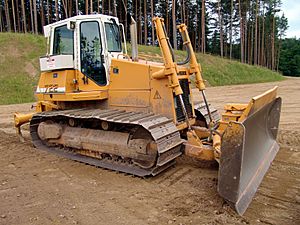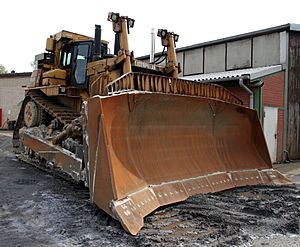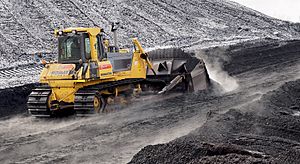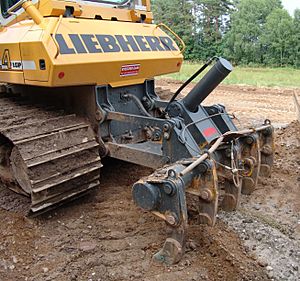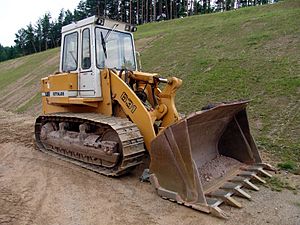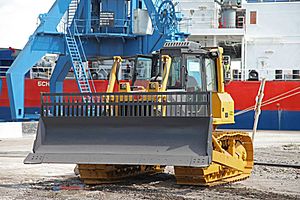Bulldozer facts for kids
Bulldozers are powerful machines that move on tracks, like a tank. They have a big metal blade at the front. Bulldozers are used to push huge amounts of dirt, sand, or rubble during building projects or when tearing down old structures. At the back, they often have a claw-like tool to break up hard ground.
Contents
What is a Bulldozer?
Most bulldozers are large, strong machines that move on tracks. These tracks help them grip the ground really well, even in tough places. Wide tracks spread the machine's weight over a big area. This stops the bulldozer from sinking in soft ground like sand or mud. Extra wide tracks are sometimes called swamp tracks.
Bulldozers are often used for building roads, in construction, mining, and clearing land. They are great for any big project that needs a strong machine to move earth.
There are also bulldozers with wheels. These usually have four wheels and can steer by bending in the middle. Their blade is at the front and moves with hydraulic power.
The main tools of a bulldozer are its blade and its ripper. Sometimes, people mistakenly call other similar machines, like a large front loader, a bulldozer.
The Blade
The bulldozer blade is a heavy metal plate at the front. It is used to push objects, sand, soil, and debris. There are three main types of blades:
- A straight blade ("S blade") is short and flat. It is good for making the ground very level.
- A universal blade ("U blade") is tall and curved. It has big sides to carry more material.
- An "S-U" (semi-U) blade is a mix of the two. It is shorter and less curved, with smaller sides. This blade is often used for pushing piles of large rocks.
Blades can be attached straight across the front or at an angle. Some blades can even change their angle while moving. The bottom edge of the blade can be sharpened to cut things like tree stumps.
Sometimes, a bulldozer pushes another machine called a "scraper". Many bulldozer blades have a strong middle part for this job. These are called "bull blades".
In the military, bulldozer blades are put on special combat engineering vehicles. They can also be added to other vehicles, like artillery tractors or main battle tanks. Soldiers use them to clear obstacles, remove mines, and dig shelters.
The Ripper
The ripper is a long, claw-like tool at the back of the bulldozer. Rippers can have one or many sharp teeth. A single tooth ripper is best for breaking up very hard ground. The ripper's tooth has a strong, replaceable tip made of tungsten steel.
Ripping helps break up hard rock or pavement into smaller pieces. These pieces are then easy to move. Farmers also use rippers to break up rocky or very hard earth. This makes the land ready for planting crops or trees. For example, in California's wine country, growers use bulldozers to break up old lava flows so they can plant grapevines.
Some bulldozers have a "stumpbuster" instead of a ripper. This is a single spike used to split tree stumps. Bulldozers with stumpbusters are used for clearing land.
How Bulldozers Have Changed
Over time, bulldozers have been changed to create new machines. These new machines can do jobs the original bulldozer could not.
For example, loader tractors were made by taking off the blade and adding a large bucket. Hydraulic arms lift and lower this bucket. This makes them good for scooping up earth and loading it into trucks. These are often called track loaders.
Some bulldozers have been made smaller. This allows them to work in tight spaces, like in mining.
Lightweight bulldozers are often used to clear snow. They also help prepare ski and snowboard slopes for winter sports. A very small bulldozer is sometimes called a "calfdozer".
An angledozer has a blade that can be pushed forward at one end. This makes it easier to push material to the side.
Even with these changes, the original bulldozers are still very important. They are used for clearing forests, moving earth, leveling ground, and building roads. Big bulldozers mainly prepare the land for construction. Smaller bulldozers and loader tractors then do much of the actual building work.
Armored Bulldozers

Bulldozers used in combat zones are often covered in armor. This protects the driver from bullets and flying debris. The Israeli Defence Forces' (IDF) militarized Caterpillar D9 is a well-known example. It is used for moving earth, clearing obstacles, and setting off explosives.
Some military groups have different types of armored bulldozers. Some need to be carried on a truck to their work site. Others have stronger engines and can drive themselves on roads.
Sometimes, regular people have added armor to bulldozers. They do this to stop others from getting in the way of their work. One famous example is Marvin Heemeyer, who armored his bulldozer to tear down government buildings.
History of Bulldozers
The first bulldozers were made from Holt farm tractors. These tractors were used to plow fields. Tractors were good at moving in soft ground, which helped in logging and building roads. This also led to the development of the armored tank in World War I.
In 1923, a farmer named James Cummings and a designer named J. Earl McLeod created the first bulldozer designs. A copy of their first bulldozer is in a park in Morrowville, Kansas. They got a patent for their "Attachment for Tractors" in 1925.
By the 1920s, tracked vehicles like the Caterpillar 60 were common. In the 1940s, rubber-tired vehicles also started to be used. To dig canals and build earth dams, these tractors got a big, thick metal plate at the front. At first, the driver often sat in the open without a cabin.
Early attachments for tractors appeared around 1929. They were known as "bull grader" blades. The term "bulldozer blade" became common in the mid-1930s. By the 1940s, the word "bulldozer" meant the whole machine, not just the blade.
Over the years, bulldozers became bigger and more powerful. Companies like Caterpillar, Komatsu, and John Deere made large tracked machines.
Bulldozers also became more advanced. They got automatic gearboxes and blades controlled by hydraulic systems. These hydraulic systems allowed for more precise control of the blade.
A newer change is adding GPS technology to bulldozers. This helps them control the blade very precisely for construction work.
The most famous maker of bulldozers is Caterpillar. Komatsu, Liebherr, and John Deere are also big competitors today. Bulldozers started as farm tractors but became key machines for big construction projects and military use worldwide. The Caterpillar D9 is a very famous model.
Manufacturers
In 2010, Shantui was the biggest maker of bulldozers, building over 10,000 units. Caterpillar Inc. was the next largest, making 6,400 units.
Komatsu introduced the D575A in 1981. They say their D575A-3, released in 2002, is the biggest bulldozer in the world.
History of the Word "Bulldozer"
- 19th century: The word was used in engineering for a machine that pressed metal horizontally.
- Around 1880: In the USA, a "bull-dose" meant a very large dose of medicine or punishment. "Bull-dosing" meant a severe whipping or forcing someone to do something.
- 1886: "Bulldozer" meant a large gun and the person who used it.
- Late 19th century: "Bulldozing" meant using brute force to push through any obstacle.
- 1930s: The word started to be used for the vehicle itself.
The attachments for tractors appeared as early as 1929, but they were called "bull grader" blades. The term "bulldozer blade" became common in the mid-1930s. Today, "bulldozer" refers to the whole machine. It is often shortened to "dozer".
Images for kids
-
An armored IDF Caterpillar D9 bulldozer used by Israel Defense Forces
-
Two Holt 45 gas crawling-type tractors pulling a long wagon train in the Mojave Desert during construction of the Los Angeles Aqueduct in 1909.
See also
 In Spanish: Buldócer para niños
In Spanish: Buldócer para niños


